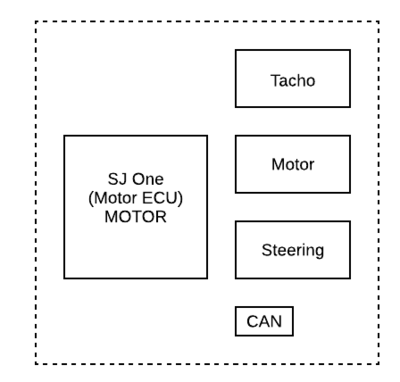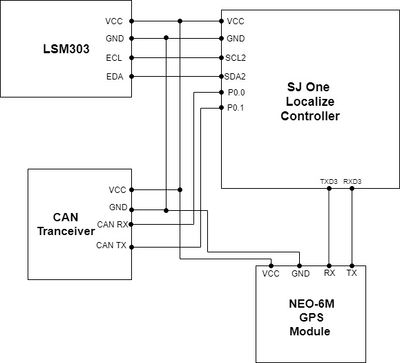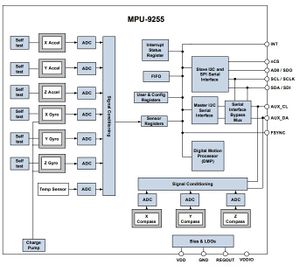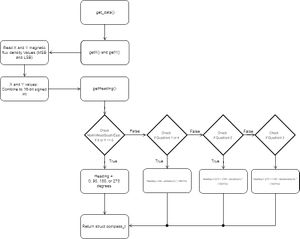Difference between revisions of "S19: CANT Bus"
Proj user4 (talk | contribs) |
Proj user4 (talk | contribs) (→Abstract) |
||
| Line 15: | Line 15: | ||
== Abstract == | == Abstract == | ||
| − | Design and implement an autonomous car to navigate to a | + | Design and implement an autonomous car to navigate to a destined location chosen by the user using a phone application. The user will set gps coordinates via an Android application while the current location is processed. The RC car should be able to use these coordinates to navigate itself to the destined location avoiding obstacles and providing useful data on the way. Several objectives need to be completed in order for the RC car to function properly: integrate proximity sensors, gps, compass, lcd screen, motor driver board, esp32 communication, hall sensor, and overall integration in order for the RC car to be able to determine where it is, the speed it's going, and the environment around it to successfully navigate to the final destination. |
=== Introduction === | === Introduction === | ||
Revision as of 19:11, 22 May 2019
Contents
Grading Criteria
- How well is Software & Hardware Design described?
- How well can this report be used to reproduce this project?
- Code Quality
- Overall Report Quality:
- Software Block Diagrams
- Hardware Block Diagrams
- Schematic Quality
- Quality of technical challenges and solutions adopted.
Project Title
[C]ompile [A]nother [N]on-[T]rivial Bus
Abstract
Design and implement an autonomous car to navigate to a destined location chosen by the user using a phone application. The user will set gps coordinates via an Android application while the current location is processed. The RC car should be able to use these coordinates to navigate itself to the destined location avoiding obstacles and providing useful data on the way. Several objectives need to be completed in order for the RC car to function properly: integrate proximity sensors, gps, compass, lcd screen, motor driver board, esp32 communication, hall sensor, and overall integration in order for the RC car to be able to determine where it is, the speed it's going, and the environment around it to successfully navigate to the final destination.
Introduction
The purpose of this project was to convert a RC car into a self driving vehicle that can navigate itself to a destination sent via an Android mobile app. To achieve this, the project was divided into 7 modules: Avoidance, Motor, Master Driver, Localize, Comms, and Android Application. The Avoidance module contains 8 IR sensors that allow the car to see the world around it. This module finds objects and measures the distance between it and the object. Motor controls a brushed motor which drives the car at various speeds and a servo to turn the car. In addition, Motor also contains a hall effect sensor that keeps track of the cars speed. Localize tells the car where it is in relation to where it needs to go. It contains a GPS and Compass to provide current coordinates and heading. Comms houses the wireless device that talks to the the mobile app as well as an LCD display to show various car data such as speed and destination. The mobile app is where the user can enter GPS coordinates as a destination point, or alter the current destination with a way-point. Lastly, the Driver receives the data from all modules and decides how the car shall react.
Team Members & Responsibilities
- Kevin Chan
- OLD!!! Lidar, Tachometer, Power, Wireless communications
- Sensors (Proximity), Compass (Localize), PCB/Schematic, Code Review
- Khrysta Finch
- Chassis, Driver, LCD display (Comms), Schematic, Telemetry (Comms)
- Andrew Javier
- OLD!!! Motor, Steering, Compass, Wireless communications (GPS, Lidar, Chasis)
- GPS (Localize), WiFi (Comms), Tachometer (Motor)
- Aaron Lee
- OLD!!! GPS, Mobile App (Compass, Telemetry)
- GPS (Localize)
- Jonathan Rojas
- OLD!!! GPS, Lidar, Tachometer, Power
- Motor, PCB/Schematic
- Vijay Vanapalli
- OLD!!! Motor, Steering, PCB/Schematic (Mobile App)
- GPS (Localize), WiFi (Comms), Mobile app
- Nelson Wong
- Team Leader, Driver, Telemetry (Comms), PCB/Schematic, Chassis, Mobile App, Power, Code Review
Source Code
Modules
- Driver
- Proximity
- Kevin Chan
- Nelson Wong?
- Motor
- Localize
- Vijay Vanapalli
- Aaron Lee
- Andrew Javier
- Kevin Chan
- Comms
- Andrew Javier
- Vijay Vanapalli
- Khrysta Finch
- Android Application
- Vijay Vanapalli
- Testing Team
- Kevin Chan
- Nelson Wong
Schedule
Show a simple table or figures that show your scheduled as planned before you started working on the project. Then in another table column, write down the actual schedule so that readers can see the planned vs. actual goals. The point of the schedule is for readers to assess how to pace themselves if they are doing a similar project.
| Week# | Start Date | End Date | Task Description | Status | Completion Date |
|---|---|---|---|---|---|
| 1 | 3/4 | 3/10 |
|
Complete | |
| 2 | 3/11 | 3/17 |
|
||
| 3 | 3/18 | 3/24 |
|
||
| 4 | 3/25 | 3/31 |
|
||
| 5 | 4/1 | 4/7 |
|
||
| 6 | 4/8 | 4/14 |
|
||
| 7 | 4/15 | 4/21 |
|
||
| 8 | 4/22 | 4/28 |
|
||
| 9 | 4/29 | 5/5 |
|
||
| 10 | 5/6 | 5/12 |
|
Parts List & Cost
| Item# | Part Desciption | Vendor | Qty | Cost |
|---|---|---|---|---|
| 1 | RC Car | Traxxas | 1 | $250.00 |
| 2 | CAN Transceivers MCP2551-I/P | Microchip [1] | 8 | Free Samples |
Printed Circuit Board
<Picture and information, including links to your PCB>
CAN Communication
<Talk about your message IDs or communication strategy, such as periodic transmission, MIA management etc.>
Hardware Design
<Show your CAN bus hardware design>
CAN Communication
243.dbc
VERSION "1.0"
NS_ :
BA_
BA_DEF_
BA_DEF_DEF_
BA_DEF_DEF_REL_
BA_DEF_REL_
BA_DEF_SGTYPE_
BA_REL_
BA_SGTYPE_
BO_TX_BU_
BU_BO_REL_
BU_EV_REL_
BU_SG_REL_
CAT_
CAT_DEF_
CM_
ENVVAR_DATA_
EV_DATA_
FILTER
NS_DESC_
SGTYPE_
SGTYPE_VAL_
SG_MUL_VAL_
SIGTYPE_VALTYPE_
SIG_GROUP_
SIG_TYPE_REF_
SIG_VALTYPE_
VAL_
VAL_TABLE_
BS_:
BU_: COMMS DRIVER LOCALIZE MOTOR AVOIDANCE
BO_ 10 KILL_MOTOR: 1 DRIVER
SG_ KILL_MOTOR_cmd : 0|8@1+ (1,0) [0|0] "" MOTOR,COMMS
BO_ 11 KILL_MOTOR_REMOTE: 1 COMMS
SG_ KILL_MOTOR_cmd : 0|8@1+ (1,0) [0|0] "" DRIVER
BO_ 100 DRIVER_HEARTBEAT: 1 DRIVER
SG_ DRIVER_HEARTBEAT_cmd : 0|8@1+ (1,0) [0|0] "" LOCALIZE,COMMS,AVOIDANCE,MOTOR
BO_ 101 MOTOR_CMD: 2 DRIVER
SG_ MOTOR_CMD_steer : 0|6@1+ (1,-30) [-30|30] "degrees" MOTOR
SG_ MOTOR_CMD_drive : 8|7@1+ (1,0) [0|100] "" MOTOR
BO_ 200 AVOIDANCE_LIDAR: 8 AVOIDANCE
SG_ LIDAR_f_right : 0|8@1+ (1,0) [0|0] "cm" DRIVER
SG_ LIDAR_f_middle : 8|8@1+ (1,0) [0|0] "cm" DRIVER
SG_ LIDAR_f_left : 16|8@1+ (1,0) [0|0] "cm" DRIVER
SG_ LIDAR_b_right : 24|8@1+ (1,0) [0|0] "cm" DRIVER
SG_ LIDAR_b_middle : 32|8@1+ (1,0) [0|0] "cm" DRIVER
SG_ LIDAR_b_left : 40|8@1+ (1,0) [0|0] "cm" DRIVER
BO_ 300 LOCALIZE_GPS: 8 LOCALIZE
SG_ GPS_STATUS : 0|8@1+ (1,0) [0|0] "" DRIVER,COMMS
SG_ GPS_TX_LATITUDE : 8|24@1+ (0.000001,37.000000) [37.000000|38.000000] "degrees" DRIVER,COMMS
SG_ GPS_TX_LONGITUDE : 32|24@1- (0.000001,-122.000000) [-122.000000|-121.000000] "degrees" DRIVER,COMMS
BO_ 301 LOCALIZE_IMU: 8 LOCALIZE
SG_ IMU_STATUS : 0|8@1+ (1,0) [0|0] "" DRIVER,COMMS
SG_ IMU_COMPASS : 8|12@1+ (0.1,0) [0|360.0] "degrees" DRIVER,COMMS
BO_ 302 SPEED: 8 LOCALIZE
SG_ SPEED_kph : 0|16@1- (0.001,0) [-5|10] "kph" COMMS,DRIVER
BO_ 400 MOTOR_STATUS: 1 MOTOR
SG_ MOTOR_STATUS_data : 0|8@1+ (1,0) [0|0] "" COMMS,DRIVER
BO_ 500 SET_WAYPOINT: 8 COMMS
SG_ SET_WAYPOINT_LAT : 0|24@1+ (0.000001,37.000000) [37.000000|38.000000] "degrees" DRIVER
SG_ SET_WAYPOINT_LONG : 24|24@1- (0.000001,-122.000000) [-122.000000|-121.000000] "degrees" DRIVER
BO_ 501 SET_STATUS: 1 COMMS
SG_ SET_STATUS_cmd : 0|8@1+ (1,0) [0|0] "" DRIVER
CM_ BU_ DRIVER "The driver controller driving the car";
CM_ BU_ MOTOR "The motor controller of the car";
CM_ BU_ LOCALIZE "The localization controller of the car";
CM_ BU_ AVOIDANCE "The collision avoidance controller of the car";
CM_ BU_ COMMS "The wireless comms and telemetry controller of the car";
CM_ BO_ 100 "Sync message used to synchronize the controllers";
CM_ BO_ 501 "0: stop, 1: ready, 2: navigate, 3: skip/next"
BA_DEF_ "BusType" STRING ;
BA_DEF_ BO_ "GenMsgCycleTime" INT 0 0;
BA_DEF_ SG_ "FieldType" STRING ;
BA_DEF_DEF_ "BusType" "CAN";
BA_DEF_DEF_ "FieldType" "";
BA_DEF_DEF_ "GenMsgCycleTime" 0;
BA_ "GenMsgCycleTime" BO_ 500 100;
BA_ "GenMsgCycleTime" BO_ 100 1000;
BA_ "GenMsgCycleTime" BO_ 101 100;
BA_ "GenMsgCycleTime" BO_ 400 100;
BA_ "GenMsgCycleTime" BO_ 200 100;
BA_ "FieldType" SG_ 500 DBC_TEST1_enum "DBC_TEST1_enum";
BA_ "FieldType" SG_ 100 DRIVER_HEARTBEAT_cmd "DRIVER_HEARTBEAT_cmd";
VAL_ 500 DBC_TEST1_enum 2 "DBC_TEST1_enum_val_two" 1 "DBC_TEST1_enum_val_one" ;
VAL_ 100 DRIVER_HEARTBEAT_cmd 2 "DRIVER_HEARTBEAT_cmd_REBOOT" 1 "DRIVER_HEARTBEAT_cmd_SYNC" 0 "DRIVER_HEARTBEAT_cmd_NOOP" ;Proximity ECU
<Picture and link to Gitlab>
Hardware Design
Software Design
<List the code modules that are being called periodically.>
Technical Challenges
<Bullet or Headings of a module>
Unreliable sonor sensors
<Problem Summary> <Problem Resolution>
Motor ECU
Hardware Design
Software Design
<List the code modules that are being called periodically.>
Technical Challenges
<Bullet or Headings of a module>
Unreliable Servo Motors
<Problem Summary> <Problem Resolution>
Localize ECU
Hardware Design
The geographical/localization controller (SJOne board) was connected to a compass and GPS module.
The compass that we are using for this project is an MPU-9255 which consist of an accelerometer, gyrometer, and three-axis magnetometer. For our purpose, only the magnetometer is used to find the direction of where the car is facing, which connects to the geographical controller via I2C. As you can see in the block diagram from this module, we will only need to connect to the AUX_DA (EDA) and AUX_CL (ECL), from the compass, to the SDA2 and SCL2, respectively. The connections to the auxiliary ports of this module will bypass the accelerometer and gyrometer completely.
The GPS module that was selected was a Ublox Neo-6M module. The GPS communicates with the geographical controller via UART.
Software Design
For the compass, the get_data() modules is being called periodically in the c_periodic_callbacks file in the 100 Hz function. We want the sensor data to be sent to the CAN bus at a 20 Hz frequency, which is implemented by using an if-statement and a modulo 5 on the count variable which results to updated sensor value at 20 Hz: if(count % 5 == 1){}
The get_data() function will return a structure called 'compass_t'. In this structure, it groups three data values for the heading of the compass, the x and y-raw value of the magnetic flux density as a signed 16-bit integer and the calculated heading, which returns as a float. When calling the get_data() functions, it retrieves the X and Y-raw values of the magnetic flux density and then calculates the heading as shown in the diagram below.
Technical Challenges
- Initial Communication with Device
- When referring to the datasheet for the MPU-9255 magnetometer, the connections of the SJ One board was originally connected from the SCL2 and SDA2 to MPU-9255's SCL and SDA pins, respectively. When trying to read the magnetometer data from the specified X and Y MSB/LSB registers, no values were being returned. This had to do with a Pass-by mode that needed to be configured when initializing the accelerometer/gyrometer/magneotmeter. By revieewing the block diagram of the MPU-9255, we saw that it is possible to ignore the accelerometer and gyrometer altogether. So the compass data was accessed by connecting to the ECL and EDA pins on the breakout board instead.
- For the compass [3], the data sheet stated that the I2C device address is 0x0C. When trying to read the 'Who Am I' register at address 0x00 using I2C, this was used to see that the communication was working properly between both devices. It should return a 0x48 in response. However, we were not able to get any data being read from the register. Using the terminal command 'i2c discover', the device address of the magnetometer was found to be 0x18 instead which is 0x0C << 1.
- Single Measurement of Compass
- When initializing the compass/magnetometer, we check the "Who Am I" register to make sure that the device is communicating properly with the geographical controller. Then, it is set to a continuous measurement mode by setting one of the bits in the control register. After doing this, the expected behavior was that X and Y raw values of the magnetometer would be read continuously. However that was not the case because when we tried accessing the register for a new measurement, it would read the same value as before. The solution for this problem was to initiate a soft reset after every measurement is made. After the soft reset, we would have to re-initiate the compass again.
- Heading of Compass
- For finding the degrees values with the compass with respect to North, there was a problem where the degrees was not being calculated properly for quadrants two and three. Using arc tangent to calculate the heading value, this only works within the domain of -pi/2 to +pi/2, which is for quadrant 1 and 4. To solve this problem, a different logic was applied where it was based with respect to the WEST and SOUTH poles. After figuring this out, the compass was able to rotate and change as expected for quadrants 2 and 3. The get_heading() function is implemented as shown in Figure X: Compass heading calculation Flow.
<Bullet or Headings of a module>
Unreliable GPS lock
<Problem Summary> <Problem Resolution>
Comms ECU & LCD
<Picture and link to Gitlab>
Hardware Design
Software Design
<List the code modules that are being called periodically.>
Technical Challenges
<Bullet or Headings of a module>
Insane Bug
<Problem Summary> <Problem Resolution>
Driver Module
<Picture and link to Gitlab>
Hardware Design
Software Design
<List the code modules that are being called periodically.>
Technical Challenges
<Bullet or Headings of a module>
Improper Unit Testing
<Problem Summary> <Problem Resolution>
Mobile Application
<Picture and link to Gitlab>
Hardware Design
Software Design
<List the code modules that are being called periodically.>
Technical Challenges
<Bullet or Headings of a module>
Wifi Link Reliability
<Problem Summary> <Problem Resolution>
Conclusion
<Organized summary of the project>
<What did you learn?>
Project Video
Project Source Code
https://gitlab.com/cant-bus/cant-bus
Advise for Future Students
<Bullet points and discussion>



